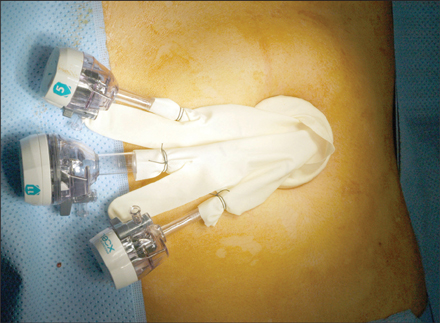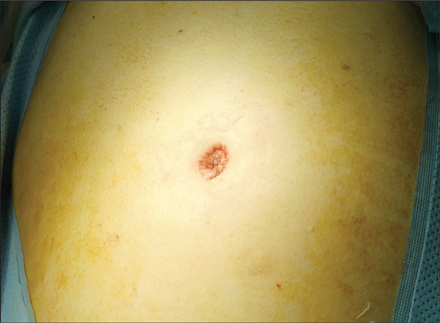J Korean Surg Soc.
2013 Aug;85(2):68-74. 10.4174/jkss.2013.85.2.68.
A comparison of transumbilical single-port laparoscopic appendectomy and conventional three-port laparoscopic appendectomy: from the diagnosis to the hospital cost
- Affiliations
-
- 1Department of Surgery, Ewha Womans University School of Medicine, Seoul, Korea. kimyi@ewha.ac.kr
- KMID: 2212519
- DOI: http://doi.org/10.4174/jkss.2013.85.2.68
Abstract
- PURPOSE
Recently many cases of appendectomy have been conducted by single-incision laparoscopic technique. The aim of this study is to figure out the benefits of transumbilical single-port laparoscopic appendectomy (TULA) compared with conventional three-port laparoscopic appendectomy (CTLA).
METHODS
From 2010 to 2012, 89 patients who were diagnosed as acute appendicitis and then underwent laparoscopic appendectomy a single surgeon were enrolled in this study and with their medical records were reviewed retrospectively. Cases of complicated appendicitis confirmed on imaging tools and patients over 3 points on the American Society of Anesthesia score were excluded.
RESULTS
Among the total of 89 patients, there were 51 patients in the TULA group and 38 patients in the CTLA group. The visual analogue scale (VAS) of postoperative day (POD) #1 was higher in the TULA group than in the CTLA group (P = 0.048). The operative time and other variables had no statistical significances (P > 0.05).
CONCLUSION
Despite the insufficiency of instruments and the difficulty of handling, TULA was not worse in operative time, VAS after POD #2, and the total operative cost than CTLA. And, if there are no disadvantages of TULA, TULA may be suitable in substituting three-port laparoscopic surgery and could be considered as one field of natural orifice transluminal endoscopic surgery with the improvement and development of the instruments and revised studies.
Keyword
MeSH Terms
Figure
Reference
-
1. Towfigh S, Chen F, Mason R, Katkhouda N, Chan L, Berne T. Laparoscopic appendectomy significantly reduces length of stay for perforated appendicitis. Surg Endosc. 2006. 20:495–499.2. Khan MN, Fayyad T, Cecil TD, Moran BJ. Laparoscopic versus open appendectomy: the risk of postoperative infectious complications. JSLS. 2007. 11:363–367.3. Golub R, Siddiqui F, Pohl D. Laparoscopic versus open appendectomy: a metaanalysis. J Am Coll Surg. 1998. 186:545–553.4. Gupta A, Shrivastava UK, Kumar P, Burman D. Minilaparoscopic versus laparoscopic cholecystectomy: a randomised controlled trial. Trop Gastroenterol. 2005. 26:149–151.5. Giday SA, Kantsevoy SV, Kalloo AN. Principle and history of Natural Orifice Translumenal Endoscopic Surgery (NOTES). Minim Invasive Ther Allied Technol. 2006. 15:373–377.6. Wu C, Prachand VN. Reverse NOTES: a hybrid technique of laparoscopic and endoscopic retrieval of an ingested foreign body. JSLS. 2008. 12:395–398.7. Buess GF. Natural orifice transluminal endoscopic surgery (NOTES). Minim Invasive Ther Allied Technol. 2008. 17:329–330.8. Arezzo A, Repici A, Kirschniak A, Schurr MO, Ho CN, Morino M. New developments for endoscopic hollow organ closure in prospective of NOTES. Minim Invasive Ther Allied Technol. 2008. 17:355–360.9. Kalloo AN, Singh VK, Jagannath SB, Niiyama H, Hill SL, Vaughn CA, et al. Flexible transgastric peritoneoscopy: a novel ap proach to diagnostic and therapeutic interventions in the peritoneal cavity. Gastrointest Endosc. 2004. 60:114–117.10. McBurney C. IV. The incision made in the abdominal wall in cases of appendicitis, with a description of a new method of operating. Ann Surg. 1894. 20:38–43.11. Semm K. Endoscopic appendectomy. Endoscopy. 1983. 15:59–64.12. Pelosi MA, Pelosi MA 3rd. Laparoscopic appendectomy using a single umbilical puncture (minilaparoscopy). J Reprod Med. 1992. 37:588–594.13. Lee J, Baek J, Kim W. Laparoscopic transumbilical single-port appendectomy: initial experience and comparison with three-port appendectomy. Surg Laparosc Endosc Percutan Tech. 2010. 20:100–103.14. Lee SY, Lee HM, Hsieh CS, Chuang JH. Transumbilical laparoscopic appendectomy for acute appendicitis: a reliable one-port procedure. Surg Endosc. 2011. 25:1115–1120.15. St Peter SD, Adibe OO, Juang D, Sharp SW, Garey CL, Laituri CA, et al. Single incision versus standard 3-port laparoscopic appendectomy: a prospective randomized trial. Ann Surg. 2011. 254:586–590.16. Mintz Y, Horgan S, Cullen J, Stuart D, Falor E, Talamini MA. NOTES: a review of the technical problems encountered and their solutions. J Laparoendosc Adv Surg Tech A. 2008. 18:583–587.17. Kim J, Lim H, Lee SI, Kim YJ. Thickness of rectus abdominis muscle and abdominal subcutaneous fat tissue in adult women: correlation with age, pregnancy, laparotomy, and body mass index. Arch Plast Surg. 2012. 39:528–533.18. Butler M, Servaes S, Srinivasan A, Edgar JC, Del Pozo G, Darge K. US depiction of the appendix: role of abdominal wall thickness and appendiceal location. Emerg Radiol. 2011. 18:525–531.19. Fuchs F, Houllier M, Voulgaropoulos A, Levaillant JM, Colmant C, Bouyer J, et al. Factors affecting feasibility and quality of second-trimester ultrasound scans in obese pregnant women. Ultrasound Obstet Gynecol. 2013. 41:40–46.20. Sugiura T, Uesaka K, Ohmagari N, Kanemoto H, Mizuno T. Risk factor of surgical site infection after pancreaticoduodenectomy. World J Surg. 2012. 36:2888–2894.21. Chouillard E, Dache A, Torcivia A, Helmy N, Ruseykin I, Gumbs A. Single-incision laparoscopic appendectomy for acute appendicitis: a preliminary experience. Surg Endosc. 2010. 24:1861–1865.22. Bergman S, Melvin WS. Natural orifice translumenal endoscopic surgery. Surg Clin North Am. 2008. 88:1131–1148.23. Palanivelu C, Rajan PS, Rangarajan M, Parthasarathi R, Senthilnathan P, Praveenraj P. Transumbilical endoscopic appendectomy in humans: on the road to NOTES: a prospective study. J Laparoendosc Adv Surg Tech A. 2008. 18:579–582.24. Palanivelu C, Rajan PS, Rangarajan M, Prasad M, Kalyanakumari V, Parthasarathi R, et al. NOTES: transvaginal endoscopic cholecystectomy in humans-preliminary report of a case series. Am J Gastroenterol. 2009. 104:843–847.25. Leroy J, Cahill RA, Asakuma M, Dallemagne B, Marescaux J. Single-access laparoscopic sigmoidectomy as definitive surgical management of prior diverticulitis in a human patient. Arch Surg. 2009. 144:173–179.26. Kang KC, Lee SY, Kang DB, Kim SH, Oh JT, Choi DH, et al. Application of single incision laparoscopic surgery for appendectomies in patients with complicated appendicitis. J Korean Soc Coloproctol. 2010. 26:388–394.27. Lee JS, Hong TH, Kim JG. A comparison of the periumbilical incision and the intraumbilical incision in laparoscopic appendectomy. J Korean Surg Soc. 2012. 83:360–366.28. Kim HO, Yoo CH, Lee SR, Son BH, Park YL, Shin JH, et al. Pain after laparoscopic appendectomy: a comparison of transumbilical single-port and conventional laparoscopic surgery. J Korean Surg Soc. 2012. 82:172–178.29. Park JH, Hyun KH, Park CH, Choi SY, Choi WH, Kim DJ, et al. Laparoscopic vs transumbilical single-port laparoscopic appendectomy; results of prospective randomized trial. J Korean Surg Soc. 2010. 78:213–218.30. Lee YS, Kim JH, Moon EJ, Kim JJ, Lee KH, Oh SJ, et al. Comparative study on surgical outcomes and operative costs of tran sumbilical single-port laparoscopic appendectomy versus conventional laparoscopic appendectomy in adult patients. Surg Laparosc Endosc Percutan Tech. 2009. 19:493–496.
- Full Text Links
- Actions
-
Cited
- CITED
-
- Close
- Share
- Similar articles
-
- Transumbilical Laparoscopic Assisted Single Port Appendectomy (Hybrid Appendectomy) in Children
- A Case of Single Port Laparoscopic Appendectomy and Cholecystectomy in a Fresh Cadaver: A Feasible Procedure
- Single Port Laparoscopic Appendectomy: Retrospective and Comparative Analysis of 55 Consecutive Cases: Report of Initial Experience
- Feasibility of Single-Incision Laparoscopic Appendectomy in Pregnant Women
- Single-Port Laparoscopic Appendectomy





